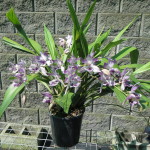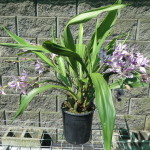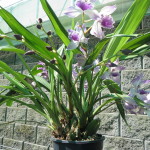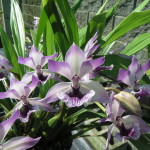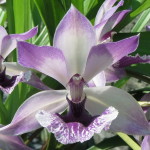Zygonisia Cynosure ‘Blue Birds’
This orchid is pretty much as close as you’ll ever get to a blue orchid. Actually one of it’s parents is Aganisia cyanea which is commonly called the Blue Orchid. Zygonisia Cynosure ‘Blue Birds’ is also one of the few orchids we grow that has a patent on it, so you’ll see on the tag US 12/942,793 which refers to the US patent.
One of the great things I love about Blue Birds is the multiple spiking that occurs on each new growth. Young plants will put up 1 spike with a new grow, but mature plants will commonly throw up 3 spikes each with 5 to 6 flowers on each as you can see from the photo taken underneath the foliage. Now when we ship plants we usually stake up the flower spike, but generally plants can just be let go to flower naturally with their spikes up and out to the side of the foliage as seen on the mature specimen in the photos.
Now due to the parentage of Aganisia cyanea this orchid loves water and good moisture. The description in Orchidwiz states that visitors to it’s native region in the upper Amazon Basin near the confluence of the Amazon and Rio Negro have found Blue Orchids almost submerged during the seasonal floods, but still growing and flowering out of the water. This parent also gives Blue Birds it’s heat loving growth, with most of the growth and flowering occurring during late spring through to mid autumn in South East Queensland. If you live in cooler regions of Australia it’s best to move Blue Birds in the warmest part of your growing area during winter. To keep the moisture up to Blue Birds we use Anova pots that have a centrally located drainage hole with a raised ring around it, so that a small amount of water is retained in the bottom of the pot to keep the potting mix moist. If you grow Blue Birds in a normal pot with plenty of drainage holes, best to keep a shallow saucer underneath it during the warmer months.
The specimen in the photos has been grown in a 175mm (7 inch) standard pot and is about 5 years old. It has grown quite happily under 50% shadecloth and doesn’t mind long periods of rain during the warmer months.

